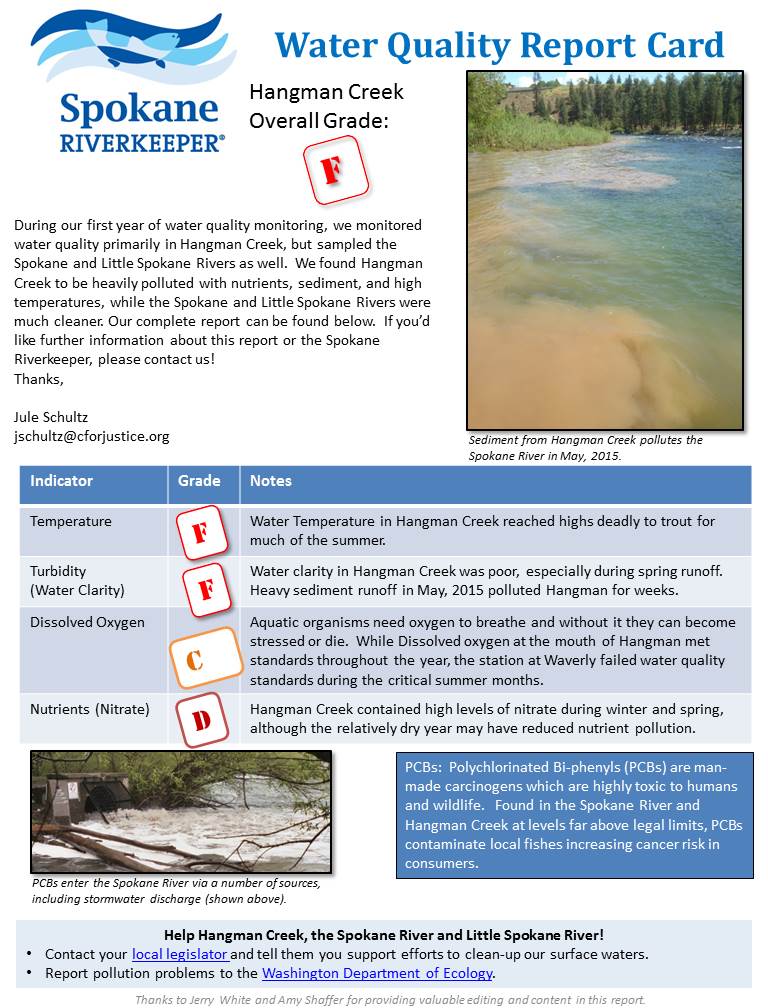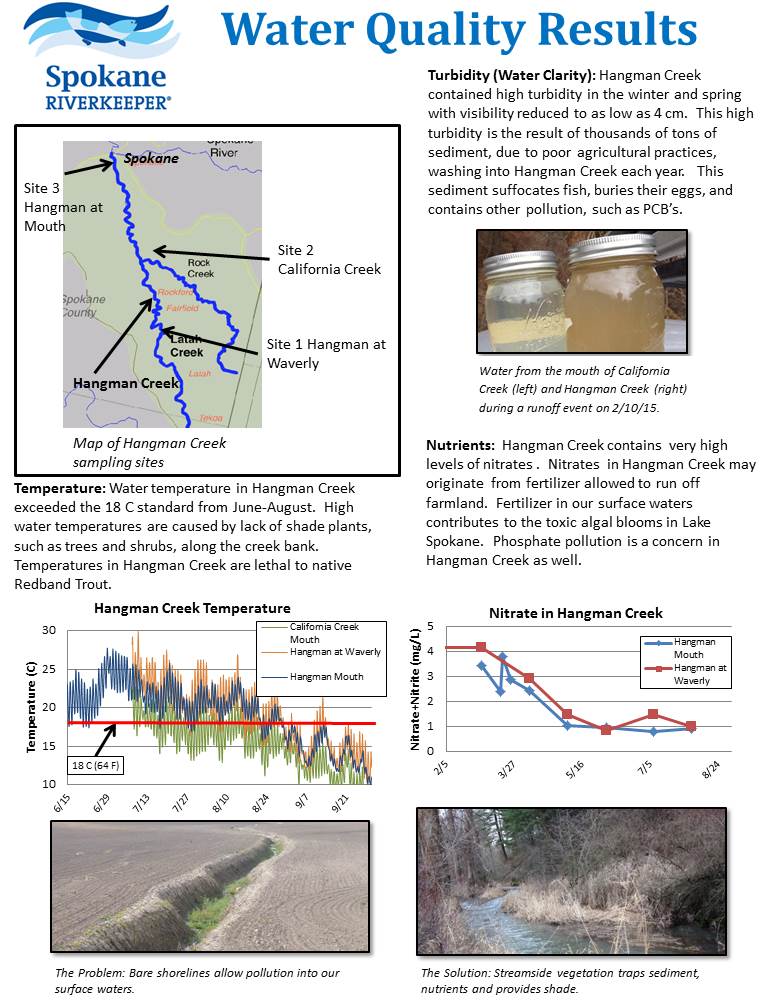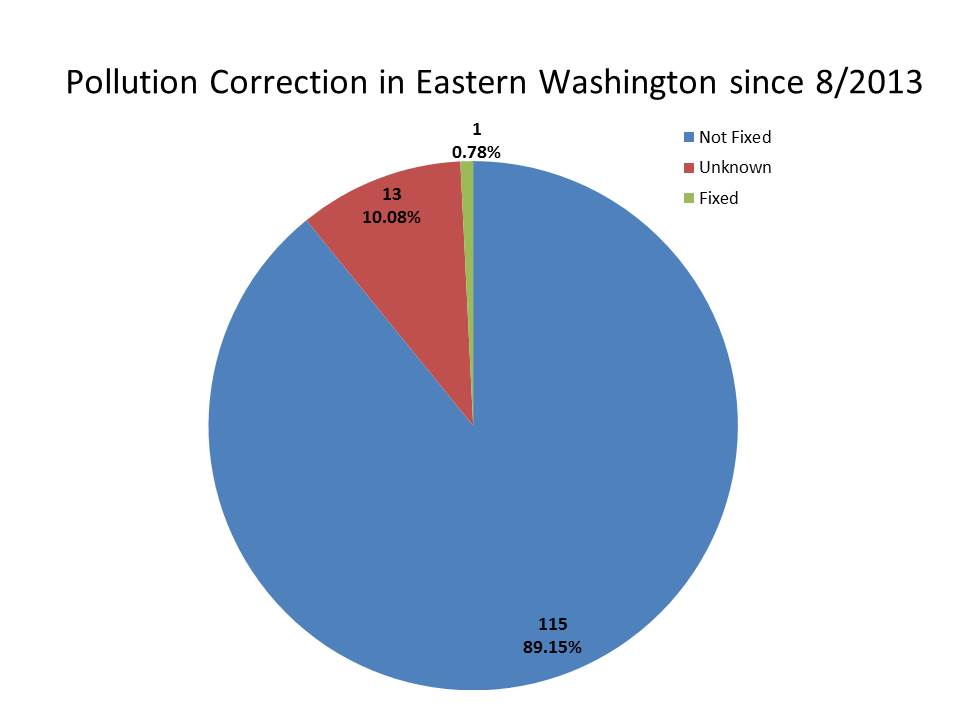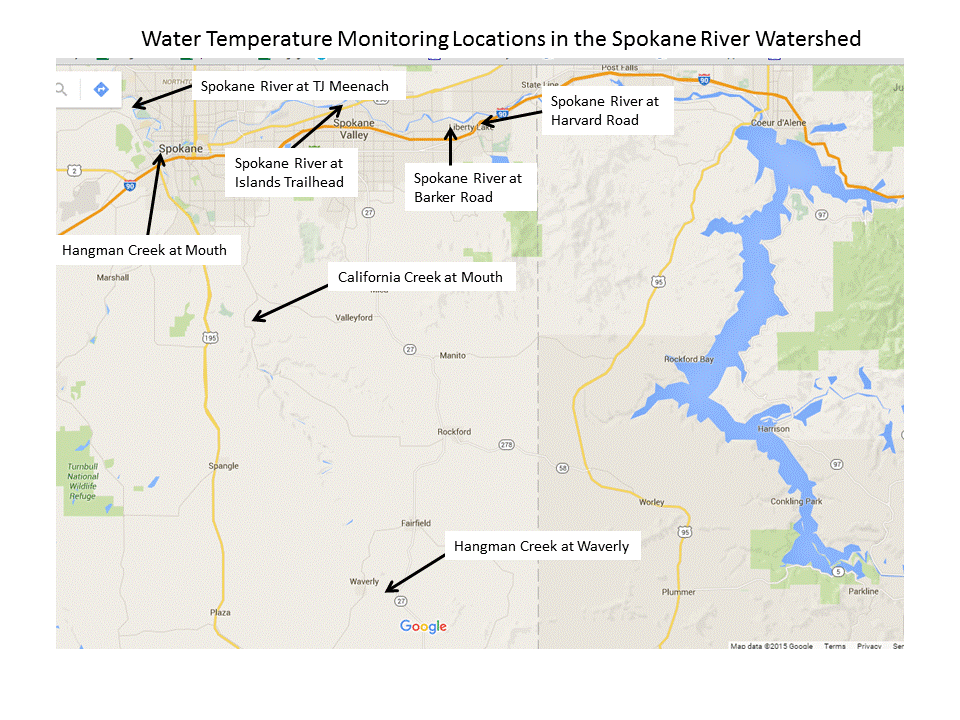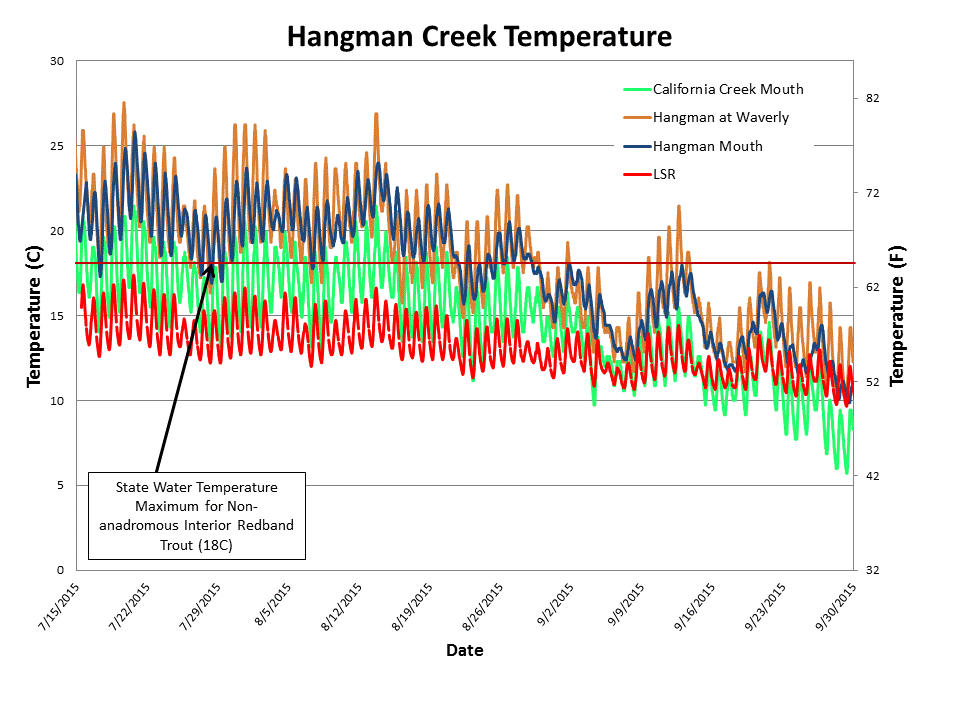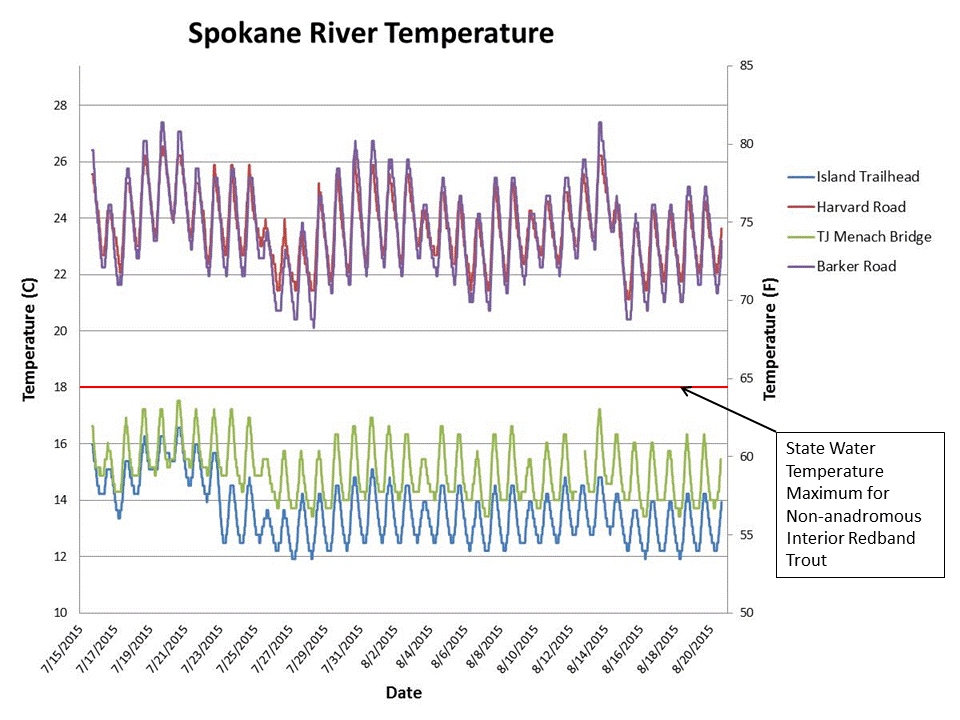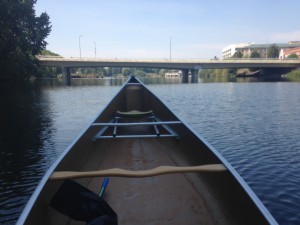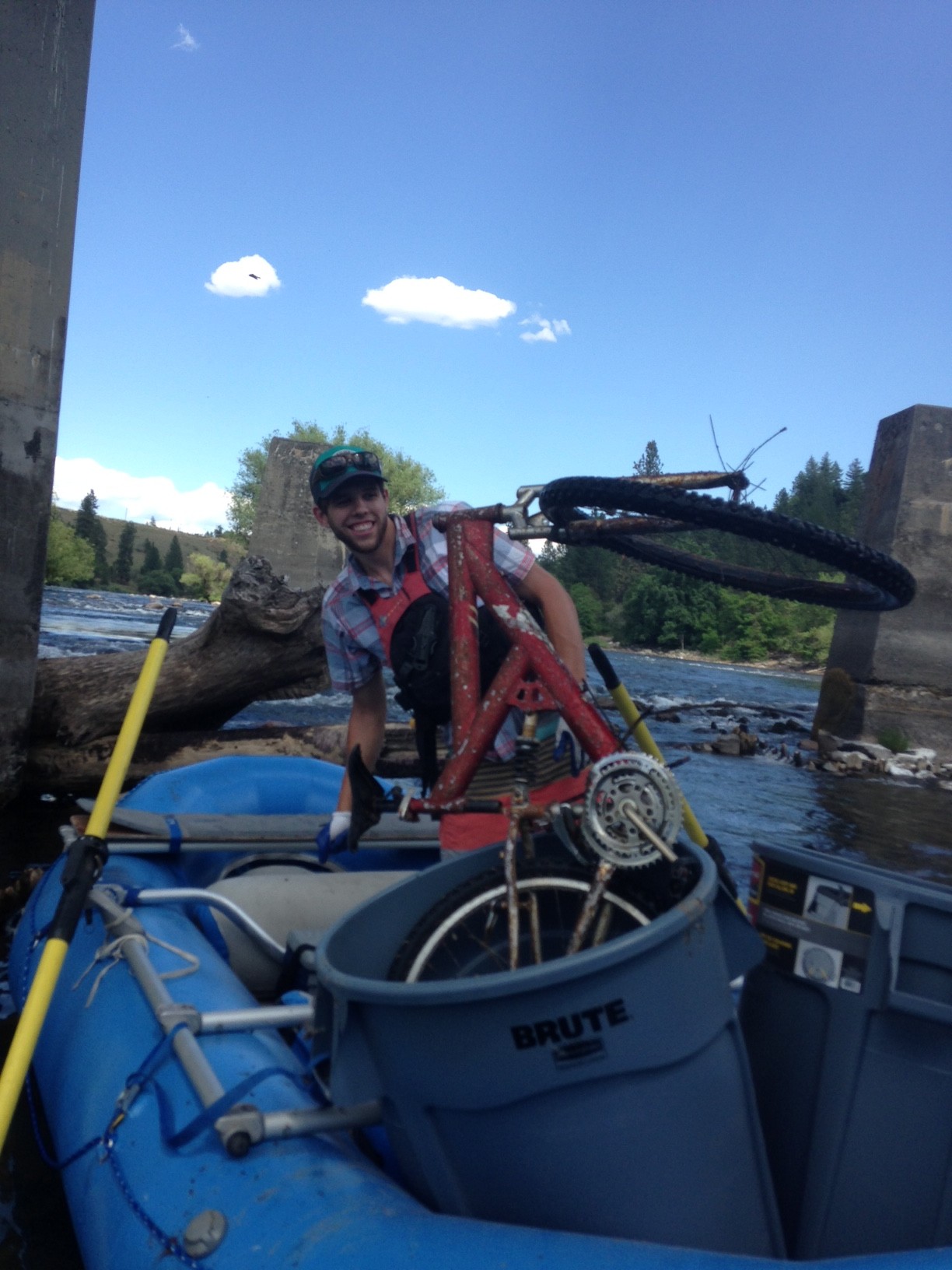During the summer of 2016, the Spokane Riverkeeper monitored water temperature in the Spokane River and Hangman Creek. The study was conducted to examine which areas of the watershed may contain unsuitable water temperatures for native Redband Trout and exceed Washington State's water temperature standards of64F (18C). Not surprisingly, much of the Hangman Creek main stem and the Spokane River above Sullivan Road exceeded these temperatures. Surprisingly, many tributaries of Hangman Creek were much cooler than expected. Warning: This is a graph heavy post, but we wanted to get the data out there and will be following up with an in-depth report soon.
Viewing entries in
riverkeeper
Spokane Riverkeeper has been hard at work over the past few months putting together comments (see link at bottom) on draft National Pollution Discharge Elimination System (NPDES) Permits for three dischargers on the Spokane River – City of Liberty Lake Waste Water Treatment Plant (WWTP), City of Spokane WWTP and Polychlorinated Biphenyls (PCBs), and Kaiser Aluminum, LLC. Our comments on these permits reflect the need for strong limits on pollutants entering our river.
A few weeks ago, we had the privilege of touring a Combined Sewage Overflow (CSO) tank currently being constructed underneath Pettit Drive (better known as Doomsday Hill). The City’s investment in multiple tanks similar to the one pictured below is preventing millions of gallons of combined sewage and stormwater overflow from ending up in our river. This project and ones like it are great news for the health of the Spokane
Rachel Fricke, a Spokane native who comes to us from the University of Southern California, is our Fall Intern. Below, she discusses our recent summer temperature findings.
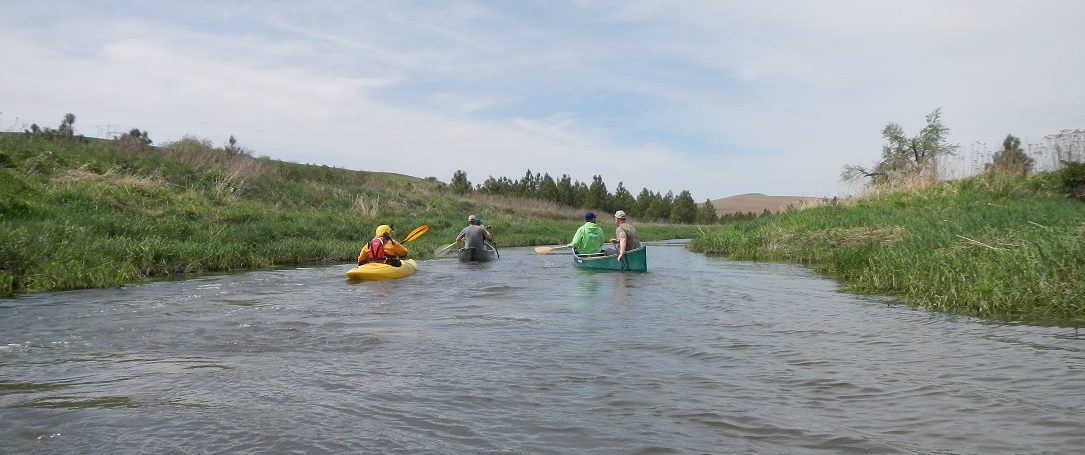
For the past month, I’ve had the pleasure of running around the Spokane River watershed collecting and recording data from temperature loggers that were placed back in June. Why does Riverkeeper care about temperature? Though temperature is not a physical or chemical pollutant, it has a direct impact on the organisms inhabiting our river and its tributaries.
The majority of freshwater-dwellers are cold-blooded, meaning their internal body temperature aligns with the temperature of their external environment. Should these organism’s internal temperatures become too hot, their cells begin to die, eventually causing mortality. Redband trout, a prominent species in the Spokane River ecosystem, live and spawn at an optimum temperature of 57.2° F. They can withstand temperature variances of a few degrees, but will not occupy regions where water temperature is significantly higher than optimum.
Our summer loggers from the Spokane River showed that temperatures reached their highest (~83° F) at the Harvard and Barker Road bridge crossings. This makes sense because these locations are upriver from where groundwater from the aquifer – which is cooler than surface water – begins feeding into the river. Further downriver at TJ Meenach we recorded a high of 63°F – a habitable temperature for Redband.

On Hangman Creek, our loggers recorded significantly elevated temperatures. At the mouth, where Hangman flows into the Spokane, temperatures peaked at 79° F. Just downstream from Tekoa at Waverly we recorded our highest water temperatures from the entire watershed – a whopping 84° F.
Hangman’s banks in this region have little to no riparian cover, also referred to as streamside forestation. Plant growth alongside streams is essential for healthy stream temperatures as it shades creek water. Hangman Creek’s current conditions in the Waverly area leave creek water directly exposed to the Palouse’s intense summer sun and heat, resulting in heightened water temperatures.
Check back within the coming weeks for a comprehensive report of this year’s temperature and water quality data. For more information on Redband trout, the Western Native Trout Initiative is a great reference.
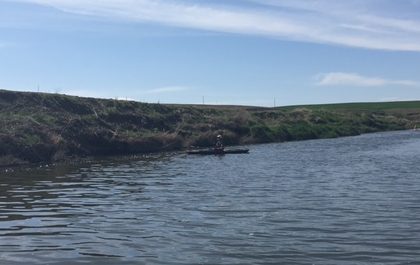
Will Tender, a student at Redlands College, interned for us this summer. He volunteered his time hauling heavy loads of garbage and helping with our water quality monitoring program. I asked him to write a short summary of what he did this summer (that's him in the blue PFD). 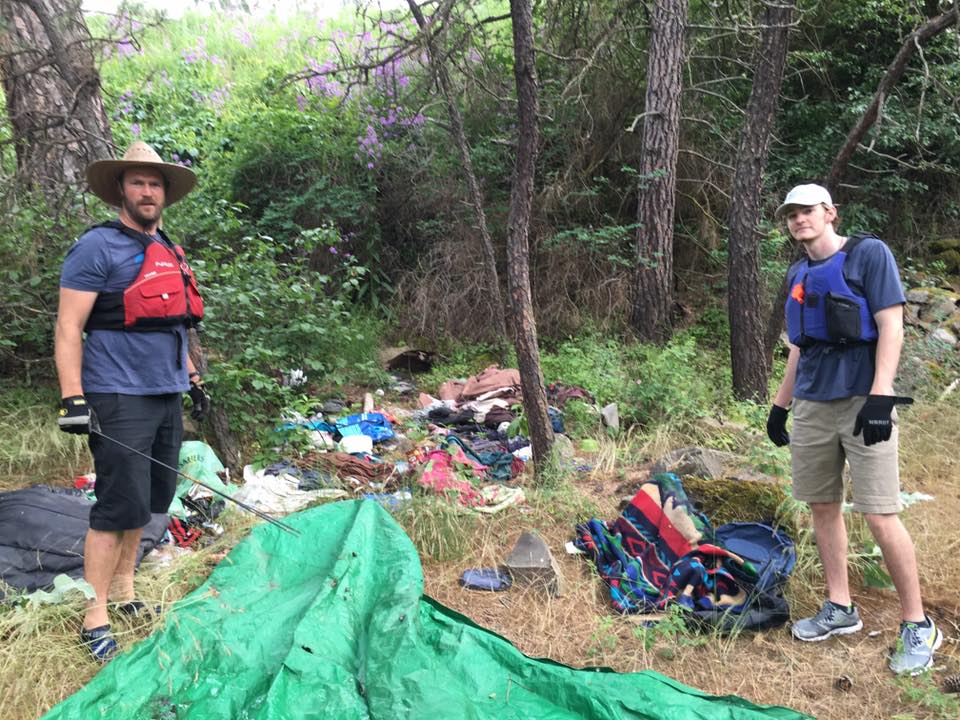 This summer I was given the opportunity to be an intern for the Spokane Riverkeeper. Throughout the experience I learned a lot about the Spokane River and Watershed. Pretty much every day I was in the field, working right beside the river. We rafted the river about once a week picking up several hundreds of pounds of garbage each day. Days we didn’t raft we would take groups out alongside the shore to pick up trash, go on water quality runs, place temperature loggers into the Watershed to help monitor the health of various spots on the river, as well as a variety of other tasks.
This summer I was given the opportunity to be an intern for the Spokane Riverkeeper. Throughout the experience I learned a lot about the Spokane River and Watershed. Pretty much every day I was in the field, working right beside the river. We rafted the river about once a week picking up several hundreds of pounds of garbage each day. Days we didn’t raft we would take groups out alongside the shore to pick up trash, go on water quality runs, place temperature loggers into the Watershed to help monitor the health of various spots on the river, as well as a variety of other tasks.
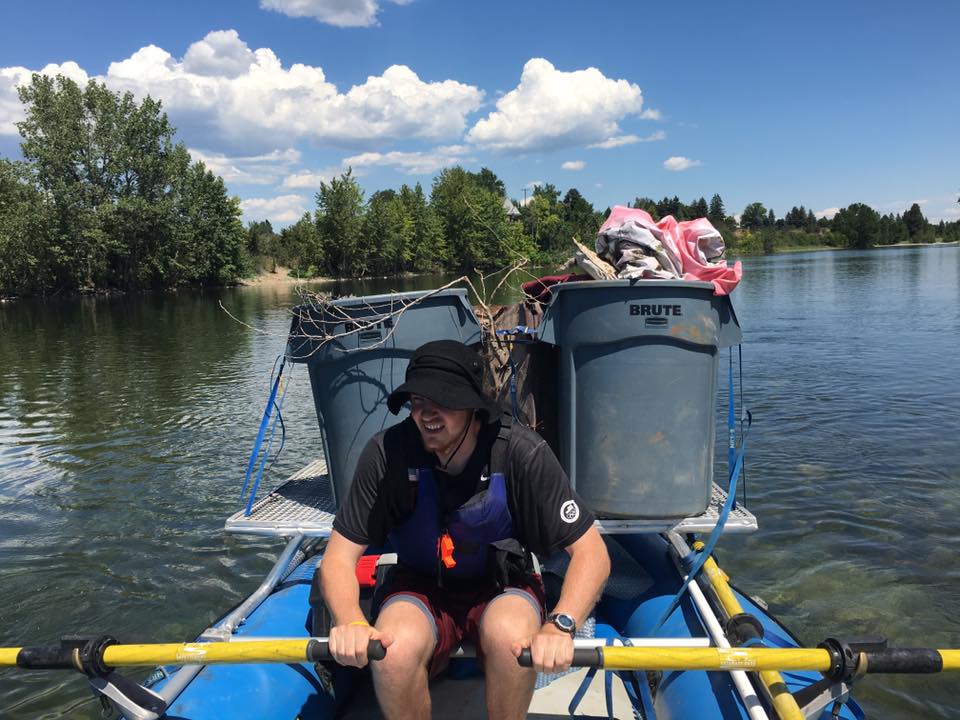 Rafting at least once a week for 3 months gives you a newfound respect and appreciation for the river. It really showed me that preservation should be taken very seriously, as something so beautiful and natural should be protected from industrialization and unnecessary pollution.
Rafting at least once a week for 3 months gives you a newfound respect and appreciation for the river. It really showed me that preservation should be taken very seriously, as something so beautiful and natural should be protected from industrialization and unnecessary pollution.
The other aspect of this experience that really altered my views was how the Riverkeeper wants people to use the river. Initially, when I began this experience I wasn’t sure the program’s stance on public usage. I thought that public usage was potentially a primary source of pollution. I came to find out that a good deal of the frequent rafters and tubers are very respectful of the river and strive to protect it. A really cool aspect of the Riverkeeper is how supportive they are of the public users, and how the program not only supports, but encourages everyone to experience the river.
Overall this opportunity opened my eyes to what goes into monitoring and protecting nature as a whole. There are so many different components that need to be addressed, and so many different players that need to be factored into the equation. This internship has been a real mentality changing experience, and I am grateful for the opportunity.
Here is our most recent Justice Lunchbox featuring Jerry White, Spokane Riverkeeper discussing the work he and Jule Schultz do regarding nonpoint source pollution on Hangman Creek and other Spokane River tributaries.
Spokane City Council takes the Courageous Stand to Call for Stop to Oil Train Traffic over our Spokane River and through Spokane, WA
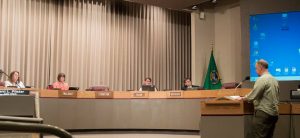 This past Monday, Jerry White, our Spokane Riverkeeper, gave testimony at the Spokane City Council meeting regarding a resolution (2016-0056) in response to the recent oil train derailment and fire in Mosier, Oregon. The resolution was passed and can be read in full below. Last Friday, 16 cars from a 96-car train transporting highly flammable Bakken crude oil derailed in the Columbia River Gorge city of Mosier, Oregon. Four of the cars then caught fire sending massive amounts of smoke into the air. About a quarter of Mosier residents were evacuated, as well as 100 students from the local school that stands only 200 feet from the site of the flaming oil. Union Pacific Railroad and the city of Mosier agree that the damage from the crash could have been even more catastrophic if the wind speed had been at the usual 25 mile per hour rate that afternoon.
This past Monday, Jerry White, our Spokane Riverkeeper, gave testimony at the Spokane City Council meeting regarding a resolution (2016-0056) in response to the recent oil train derailment and fire in Mosier, Oregon. The resolution was passed and can be read in full below. Last Friday, 16 cars from a 96-car train transporting highly flammable Bakken crude oil derailed in the Columbia River Gorge city of Mosier, Oregon. Four of the cars then caught fire sending massive amounts of smoke into the air. About a quarter of Mosier residents were evacuated, as well as 100 students from the local school that stands only 200 feet from the site of the flaming oil. Union Pacific Railroad and the city of Mosier agree that the damage from the crash could have been even more catastrophic if the wind speed had been at the usual 25 mile per hour rate that afternoon.
Jerry began his testimony by explaining that the Union Pacific Railroad has “pushed aside the derailed oil tanker cars and begun running train traffic while the burnt cars continue to smolder.” Voicing his grave concern for this reckless and unacceptable behavior, he continued to explain that the evacuated families had not yet returned home and measures had not yet been taken to clean up the spill when Union Pacific made this decision. In conclusion Jerry made clear that “the Spokane Riverkeeper stands with the city of Mosier and their Columbia River, and supports their request for a temporary halt in train traffic.” As a community voice for the river, Jerry and all of us here at the Center for Justice support this resolution and find it to be a reasonable short term response to an industry that appears to be out of control and out of touch with the norms of corporate and community responsibility.
In the end, the Spokane City Council, under the leadership of City Council President Ben Stuckart, took a courageous stance and passed Resolution 2016-0056, calling for the halt to oil train traffic through our city and over our river. We thank them for their leadership and vision in the face of this issue.
Read Jerry’s full testimony below:
"It has come to our attention that in Mosier, Oregon the Union Pacific Railroad has now pushed has aside the derailed oil tanker cars and begun running train traffic while the burnt cars still smoulder. This is happening before many evacuated families have even returned to their homes. We know that oil reached the river, leaving state officials to initiate clean-up efforts. This reeks of a “business as usual” ethos on the part of Union Pacific that is absolutely unacceptable. This is particularly outrageous in light of the fact that we do yet understand the nature of the derailment. The Spokane Riverkeeper stands with the city Mosier and their Columbia River, and supports their request for a temporary halt in train traffic. Under 49 U.S.C. 5121(d), the United States Department of Transportation has the authority to declare an emergency prohibition of future oil train shipments through Mosier until it is proven to be safe for renewed rail traffic. We understand that Oregon’s Senators Jeff Merkley and Ron Wyden, Governor Kate Brown and Representatives Earl Blumenauer and Suzanne Bonamici released the following statement today calling for a temporary halt to oil train traffic in Columbia River Gorge Saying that, and I Quote, “They (the people of Mosier, Oregon) deserve to know that the causes of this derailment have been both identified and fixed, and there should be a moratorium on oil train traffic until they get those explanations and assurances” This terrifying incident is a mere warning of the catastrophic risks that huge segments of our community have been demanding action on for months. In light of proposed oil by rail facilities on Washington’s West side, Spokane will continue to bare the risk of oil fires in our river, spills in our community, in our river and over our drinking water. We bare the risk while the Union Pacific and Burlington Northern Santa Fe Railroads reap the profits of this traffic. This is in, and of itself, is outrageous. As a community voice for the river, I absolutely support this resolution which is a sane and reasonable short term response to an industry that appears to be out of control and out of touch with the norms of corporate and community responsibility."
Find the full resolution by City Council in the link below:
For additional information on the train derailment, check out these links:
Spokane Riverkeeper is dedicated to protecting and restoring the health of the Spokane River Watershed. The Spokane Riverkeeper River Partners Program celebrates the value added to our community and economy by the Spokane River. Quality of life and the health of the economy and local businesses are related to the health of the environment. The River Partners Program provides an opportunity for businesses to become involved with the Riverkeeper program and increases the community awareness of the integral role of the Spokane River to our city. The program helps broaden and diversify the support base for Spokane Riverkeeper and creates an attitude of community stewardship towards the Spokane River. Businesses who join the Spokane Riverkeeper River Partners Program sign a pledge agreeing to the following statements:
- A healthy, swimmable and fishable Spokane River is good for our local community and our economic environment.
- Accessing and recreating on the river is an important part of the cultural and economic life of our community.
- Respecting other river users and holding professional standards with respect to health and safety of those who live, play and work on the river is a priority.
- Adopting water friendly business practices is an essential part of conducting business.
- We are committed to keeping out river clean and safe, respecting the contributions a healthy river makes to our community.
- We will connect the customers we serve with the health and beauty of our river and conduct business in a manner that demonstrates respect for the Spokane River.
In addition to signing this pledge, program members are connected with other Riverkeeper partners and receive media exposure for their businesses at Riverkeeper events as well as regular Riverkeeper updates.
Spokane businesses who are among the first to participate in the program include Numerica Credit Union, Silver Bow Fly Shop, FLOW Adventures, Kizuri, Ammonite Ink, and River City Brewing. Members have the opportunity to engage with the Riverkeeper program in four different areas:
- Financial Engagement (the giving of monetary resources)
- Policy/Program Support (includes attending meetings and signing on to letters)
- River Healthy Practices (adopting policies that favor the Spokane River)
- Volunteer/Time (participating in Riverkeeper events including the river clean-up)
The wellbeing of the environment is directly linked to wellbeing of the economy and the community in general. Jake Krummel, the Downtown Market Manager for Spokane Numerica Credit Union, stated that “The health of our local watersheds has a direct impact on the health of our community and our local environment. The advocacy and education efforts of the Spokane Riverkeeper showcase the importance of keeping our river clean, and are something Numerica is proud to support.” Participating in the Riverkeeper River Partners Program is an excellent way to protect the Spokane River, grow a business and contribute to increasing the quality of life in the Spokane community. To become a partner, please contact Jerry White at (509) 835-5211 or [email protected].
The Spokane Riverkeeper recently submitted oral comments to Ecology regarding their new fish consumption rule. Although the rule is improved from previous versions, it is still lacking. Standards for mercury, PCB's, and Arsenic are still too high and the inclusion of variances, increased compliance schedules, and and intake credits further weaken the rule. Read on for the full story:
Oral Comments on WDOE Proposed Fish Consumption Rule – April 6, 2016
The following comments are made with regards to the proposed Washington Department of Ecology Fish Consumption Rule. These comments were prepared by the Spokane Riverkeeper and read by myself, _______________ on behalf of the Spokane Riverkeeper. The Spokane Riverkeeper is a project of the Center for Justice, and we are an affiliated member of the Waterkeeper Alliance. We work to protect and restore the world’s waters so that they are healthy and usable by communities that interact with them. As such, the Spokane Riverkeeper’s stated mission is keeping the Spokane River Fishable and Swimmable.
The rule change that the Washington Department of Ecology (Ecology) has proposed takes several steps in the right direction, but falls short in helping us keep our Spokane River “Fishable” for the public.
- Ecology’s proposed rule has improved the fish consumption formula over the existing rule. The formula assumes a more realistic consumption rate of 175g of fish per/day while keeping the acceptable human health risk at 1 case of cancer in a million fish-eating residents. These standards would make Washington’s waters cleaner and its fish safer to eat. We commend Ecology for listening to the public and changing their proposed rules to be more realistic and more protective of human health.
- However, we encourage Ecology to review and revise their rule with regards to Mercury, PCBs and Arsenic. The proposed rule is not strong enough with regards to these toxins. All of these toxins bio-accumulate and bio-magnify in the food chain in such a way that makes Spokane River fish problematic to consume. In some cases, fish in the Spokane River are edible under the specific amounts and frequencies recommended in Dept of Health fish advisories. But depending on the age, species and river reach, many other types of fish too toxic to eat. The standards for PCBs are still exceeded in some fish and statewide mercury advisory remains in place making their consumption extremely problematic for pregnant women, children and folks who for cultural and economic reasons consume far more than the recommended allowance. Currently, the Environmental Protection Agency (EPA) has put forward PCB standards that are more protective and more up to date. We feel strongly that The EPA guidelines should be followed.
- Additionally, we feel that the EPA standards for both arsenic and methyl mercury should be adopted. We understand that these toxins are tough to capture, but feel strongly that inaction is not a solution. Using the older National Toxics Rule criteria is not adequate and leaves the public vulnerable to higher levels of these toxins over time.
- The proposed rule Increases timeframes for Compliance Schedules which is unacceptable. Using the language “as soon as possible” when refereeing to must meeting water quality standards is too idealistic and vague. There rule should require concrete time-limits for dischargers to meet state standards to ensure accountability that our waters are clean.
- The increased availability and/or potential use of Variances in the proposed rule is unacceptable. Ecology policy should be pushing dischargers to lower their output of dangerous chemicals at the end of pipe, precisely because of the nature and amount of pollution in a water body can be excessive and challenging. Ecology should not be providing off-ramps from meeting existing standards or providing the designated, attainable uses.
- Do not provide intake credits. Incentives should be developed to capture all pollutants coming through the systems that end up in our waters. Please construct policies that create net decreases in pollutants leaving the end-of-pipes in order to encourage dischargers to work towards cleaning up Washington’s waters.
These comments are made with the idea that we should be working towards the ultimate elimination of discharge to the nation’s rivers. Ecology’s proposed rule-making should help us get there. Please do not provide provisions that stall our progress, or avoid the tough work of getting our public waters fishable and swimmable. Thanks for the opportunity to comment.
Spokane Riverkeeper.
(For the readers reference if you need -see http://www.ecy.wa.gov/programs/wq/ruledev/wac173201A/1203ov.html for comparison)
Background links:
EPA/ comparison of proposed WDOE rule and EPA recommendations:
http://www.ecy.wa.gov/programs/wq/ruledev/wac173201A/1203ov.html
Rulemaking page:
http://www.ecy.wa.gov/programs/wq/ruledev/wac173201A/1203ov.html
WDOE info on Variances:
http://www.ecy.wa.gov/programs/wq/swqs/HHCinfo-variances.html
We attended the Spokane River Forum Conference last week and learned tons about the unique watershed we work so hard to protect. One talk stood out for me though and I wanted to share it with you. John Covert of the Washington State Department of Ecology presented on the relationship between our summertime water use and the flow of the Spokane River.
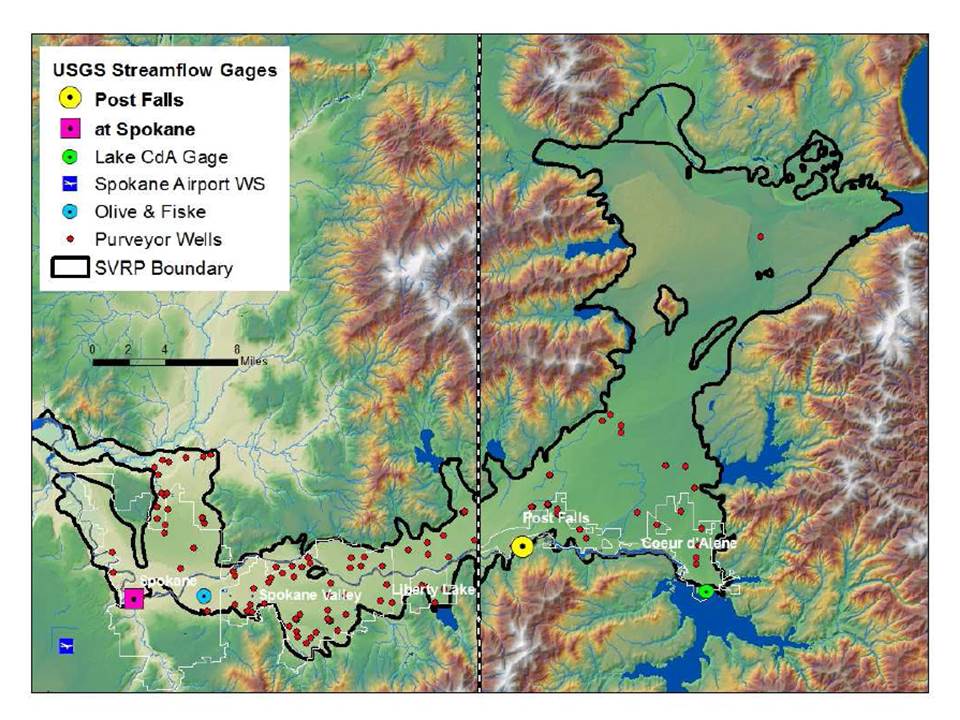
In the Spokane area we get our water from the massive 10 trillion gallon Spokane Valley-Rathdrum Prairie (SVRP) Aquifer which extends from Lake Coeur d'Alene north to Lake Pend Oreille and west to Spokane. What's interesting about this is that the river also receives water from the aquifer starting from downstream of the Sullivan Road Bridge. This cold influx from the SVRP aquifer to the river is what makes our river a great place for our native Redband Trout and to cool off in the heat of summer. The drought of 2015 allowed scientists to explore the relationship between our water use from the SVRP aquifer and River levels.
This summer was the hottest and driest on record in Spokane. Summertime river flows were the lowest on record for much of the summer. It was so dry that the Post Falls dam (yellow dot on map), which usually begins to draw down Lake Coeur d'Alene after Labor Day instead continued to discharge a relative trickle (500 cfs, red line on graph below) into the river throughout September and October. This had never happened before and allowed us to see a fascinating pattern (see graph below). Amazingly although the flow over Post Falls dam remained steady, the river began to rise at the gage in downtown Spokane (pink square on map above). Where is the extra water in the river coming from?
The explanation of this lies in the graph below. As the City of Spokane (dark blue) decreased their pumping rate the river (green) began to rise. Near the end of August the City of Spokane began to decrease their pumping rate, eventually reducing it about 70 cubic feet per second (cfs). The river began to respond in early September, eventually gaining about 90 cfs! This is approximately 13% of the river flow. Aquifer wide pumping decreased about 166 cfs during this period. Due to this reduction in pumping, the aquifer levels actually rose 0.5 ft (6 inches), resulting in more aquifer water discharging to the river. Comparing the maximum air temp (light blue) with the city pumping rate (dark blue), shows that during hot periods pumping increases.
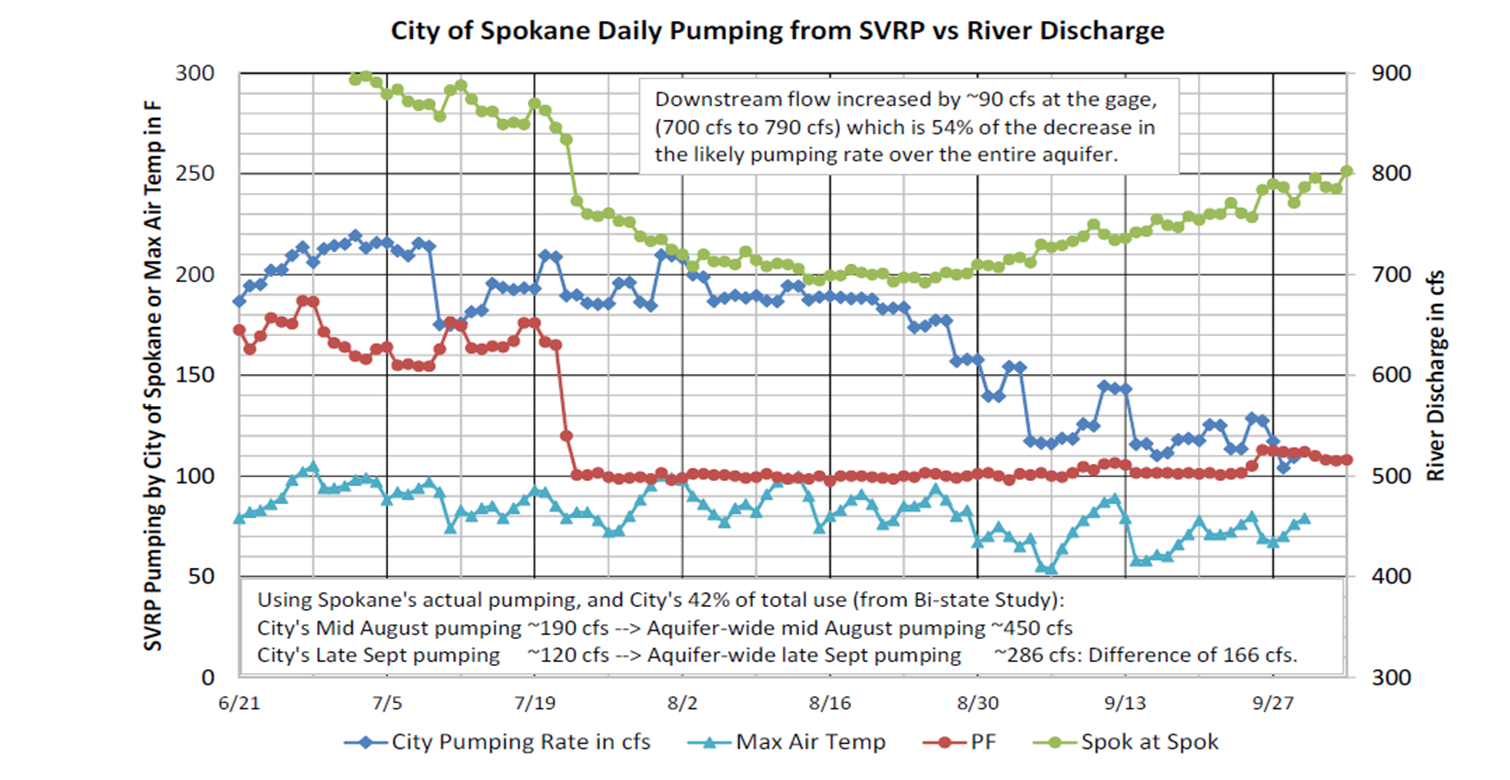
These data show that decreases in water use increase the flow of the Spokane River. I suspect the variations in pumping rate are due to the typical summertime uses, such as lawn watering, which does not return water to the river. Most importantly, we have never seen such clear data on how personal water use choices affect our Spokane River. As summertime river levels continue to drop due to decreasing snow pack (another amazing and scary talk at the conference) and municipal water use continues to grow, our choices regarding water use will have even larger impacts to our river.
For Immediate Release: January 19, 2016 Media Contacts:
Jerry White, Jr, Spokane Riverkeeper (509) 464-7614
Rick Eichstaedt, Center for Justice (509) 464-7607
Mike Petersen, The Lands Council (509) 838-4912
Adrienne Cronebaugh, Kootenai Environmental Alliance (208) 667-9093
Coalition of Conservation Groups, Industry, and Municipal Government Challenge Hatchery Permit for Impacts of PCBs to the Spokane River
Challenge seeks a permit that requires PCB testing and participating in regional PCB task force
SPOKANE, WA–Last week, a coalition of conservation groups consisting of the Spokane Riverkeeper, The Lands Council, the Kootenai Environmental Alliance, and the Lake Spokane Association, along with the Inland Empire Paper Company and the City of Coeur d’Alene filed a challenge to the Washington State Pollution Control Hearings Board of a pollution discharge permit issued by the Washington Department of Ecology for the operation of a fish hatchery on the Little Spokane River.
The appeal raises concerns about the permit’s failure to adequately address impacts of the hatchery to water quality in the Spokane River, particularly impacts from toxic polychlorinated biphenyls (PCBs). While hatcheries do not produce PCBs, a 2006 report raised concerns about the presence of PCBs in hatchery fish food, its impact on PCB levels in fish tissue, water quality impacts in the hatchery water discharge, and impacts to PCB levels in the Spokane River.
The appeal seeks measures that would require the hatchery to conduct the same type of monitoring and to participate in the Spokane River Regional Toxics Task Force (SRRTTF) in the same manner as other PCB dischargers, including Inland Empire Paper Company and the City of Coeur d’Alene.
“The Department of Ecology and the Environmental Protection Agency requires the cities and industries on the Spokane River to vigorously monitor their discharges for PCBs and to participate in a regional toxics task force,” said Jerry White, Jr., Spokane Riverkeeper. “We don’t want to shut down the hatchery,” said White. “We just want to make sure that all dischargers follow the same rules.”
“What we are after is parity,” said Mike Petersen, director of The Lands Council. “The other dischargers are spending a significant amount of money and time monitoring impacts and participating in the Toxics Task Force. It is not unreasonable to expect that the Fish and Wildlife do the same.”
“Communities on both side of the state are taking the problem of PCBs in the Spokane River seriously,” Adrienne Cronebaugh, director of the Kootenai Environmental Alliance based in Coeur d’Alene, Idaho. “That means every potential source of PCBs needs to take action to reduce and, if possible, eliminate PCBs.”
Once widely used in everything from electrical insulators to underwater paint, PCBs are now considered a long-lived pollutant associated with increased risk of cancer, reduction of immune function and impairment of the neurological development of fetuses. The family of chemicals, polychlorinated biphenyls, lasts for years in the environment. PCBs can concentrate in fat, and are passed along through the food chain when one animal eats another. PCBs are toxic in extremely small quantities. Current regulations prohibit PCB dischargers in quantities measured in the parts per quadrillion.
The Spokane Hatchery operated by the Washington Department of Fish and Wildlife was built in 1934 and is one of the State's original hatcheries. It is one of the major Rainbow Trout facilities in the state. The facility also raises German Brown Trout, Eastern Brook Trout, Cutthroat Trout, Tiger Trout, and Kokanee Salmon.
The Pollution Control Hearings Board hears appeals from orders and decisions made by the Department of Ecology. The Board consists of three members, who are appointed by the governor and confirmed by the State Senate for staggered six-year terms.
Washington State has two approaches to protect the quality of the public’s water from agricultural pollution. Sadly, neither is functioning to provide the healthy, clean water that the public is entitled to. In one approach, the federal government provides funding that is made available through the counties and the State to fund voluntary programs to address agricultural water quality problems. In the second approach, the Washington Water Pollution Control Act gives the Washington Department of Ecology (WDOE) the authority to regulate farm practices that protect water quality. This authority was upheld by the Washington Supreme Court in the Lemire vs Ecology case in August of 2013. Ideally, participation by the agricultural industry in voluntary programs would work in concert with regulatory frameworks to re-enforce a culture of lawful behavior and practices that ensure public values are protected.
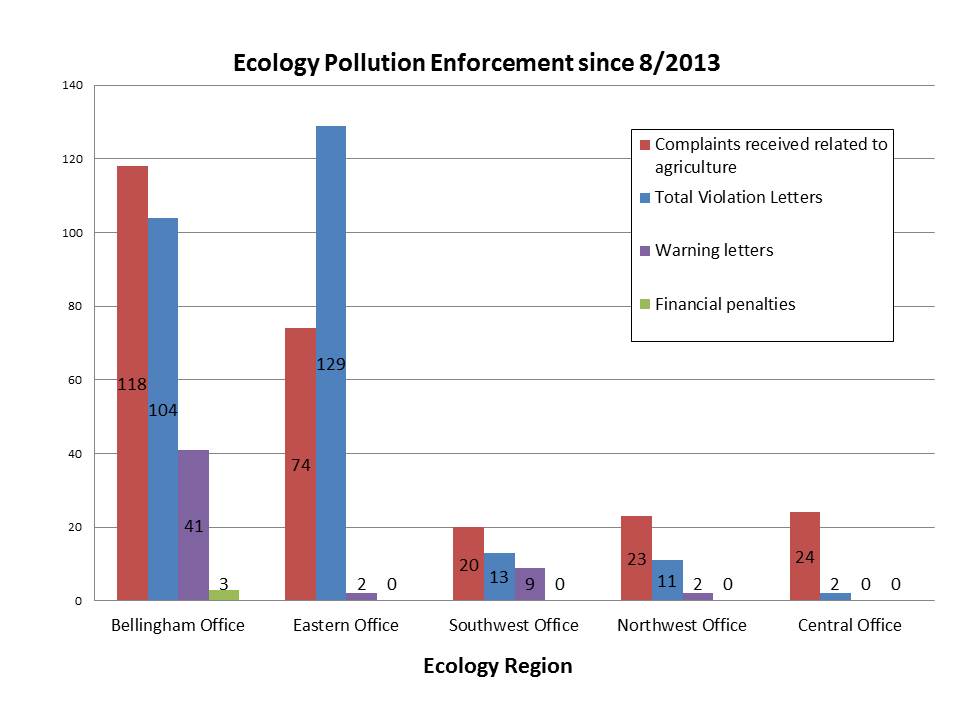
Within the regulatory process, Ecology identifies farm operations that are polluting the public’s water through citizens’ complaints and a Watershed Evaluation Process. They proceed with offering farm operations technical and financial assistance to correct their behavior and improve their practices via violation letters. If the behavior is not corrected, then punitive orders may be issued with associated fines. As a result of a Freedom Of Information request, we received data on the number of complaints, violation letters, warning letters, orders and fines levied by the Department of Ecology since the Lemire case was decided in August of 2013. We also received information on the types of pollution these violation letters addressed. These data show that Ecology's rarely uses their regulatory ability and agricultural pollution violations continue to go unaddressed in Washington State.
In the Eastern Region and the Spokane River Watershed, regulatory framework is in place but through inaction has become dysfunctional and counter-productive. For example, since the Lemire case in the Eastern Region, 74 complaints have been lodged with WDOE and 129 follow-up, violation letters that offer technical and financial assistance have been sent to farm operations that are violating water quality law. Astoundingly, no administrative orders have been issued nor fines levied. (To illustrate this pattern, see Figure 1 for comparison of Eastern Regional Office to Bellingham Field Office).
Further, records show that of those 129 problem cases identified by WDOE, only a single farm has corrected their behavior and cleaned up their operations. Inside the Eastern Region, the Spokane River tributary of Hangman Creek continues to have the worst water quality in the state (Figure 3). In this watershed our records show that out of 22 active pollution cases (since 2013) none have been corrected.
This inaction has created a norm in which agricultural industry breaks the law with impunity and virtually ignores water quality concerns. Ultimately, this inaction has sent a clear message that actual protection of the public’s surface water is not a priority for WDOE and emboldened polluters with the message that absolutely no enforcement is forthcoming for violators. In our watershed, as across the State, lawful behavior has broken down and as a result, the public is knowingly being deprived of clean water, healthy fisheries and functioning ecological corridors that our rivers should deliver. As our campaign for clean water in Washington State develops, we will soon have ways that you can let your voice be heard. Citizens speaking for clean water are the most powerful tool we have to let our legislators know that the public demands action.
Our record breaking summer has finally ended and we have pulled our temperature loggers from the Spokane River, Hangman Creek, and the Little Spokane River (see map below). Although our water temperature program was small this year (8 locations), I think that we collected some very interesting data. I previously wrote on water temperature in the Spokane River through August, so I will primarily talk about Hangman Creek in this post. I've listed some of the highlights of our data below. Scroll down for more graphs and analysis of these data.
- Water temperatures in Hangman Creek are highest at our logger in the Palouse area (Waverly) and much too high for trout both there and at the mouth, while California Creek may contain a cool water refuge.
- Water temperatures in the Spokane River at Barker and Harvard Road are much too high for trout this summer. Areas downstream of these locations saw cool temperatures suitable for trout.
- Decreasing the flow Spokane River at Post Falls from 600 to 500 cubic feet per second (cfs) causes a measurable decrease in water temperatures of the River at Islands Trailhead (near Plante's Ferry).
Our methods were simple. We placed our Hobo temperature loggers in 6" segments of white PVC tubing to shield them from the sun, secured them to a nearby tree with twine or cable, and submerged them in about 2-3 feet of water in a secluded location. The loggers read water temperature every 30 minutes, and aside from a two week hiatus, from July 15th to September 30th.
Our data showed temperatures in Hangman Creek exceed the state maximum for non-anadromous interior Redband Trout of 18 C (64 F). The graph below charts water temperature in Hangman Creek and the Little Spokane River, with temperature on the Y-axes in Celsius and Fahrenheit. The temperature at Waverly regularly exceeds 25 C (77 F), and on one day reached over 27 C (81 F)! Water temperature at the mouth of Hangman Creek was a bit lower, but remained mostly above the 18 C (64 F) mark for about a month. Interestingly, water temperature at Waverly tends to fluctuate more than at the mouth of Hangman Creek, possibly reflecting the lack of riparian buffer in the Palouse. Riparian buffer, the vegetated area along a stream, shades the creek. In the Palouse, riparian buffers have been torn out long ago in lieu of agriculture, leaving streams open to direct sunlight.
I monitored water temperature California Creek as well, which is a relatively intact stream (relative to upper Hangman ), with healthy riparian buffers in the lower portion of the creek. Water temperature here was much lower, and daily minimum temperatures fell below the 18 C (64 F)mark. Lacking any input from groundwater that I am aware of, California Creek's temperatures reflect the partially intact nature of its watershed. Lastly, Ian Townley, my colleague at St. George's School, monitored water temperatures in the Little Spokane River. Temperatures here were much lower than Hangman Creek during the hot summer months and never exceeded the 18 C mark. This is a reflection of the cold aquifer water running into the River and the intact nature of portions of this watershed.
Our Spokane River temperature data is graphed below, with water temperature and Spokane River flow on the left and right y-axes, respectively. As I wrote about earlier, the reduction of flow at Post Falls on 7/18/15 seemed to reduce the temperature at Island Trailhead. After the hot summer air temperatures ended, water temperatures reacted accordingly, dropping down by about 5 C (9 F) during the two week period we did not have loggers in the water.
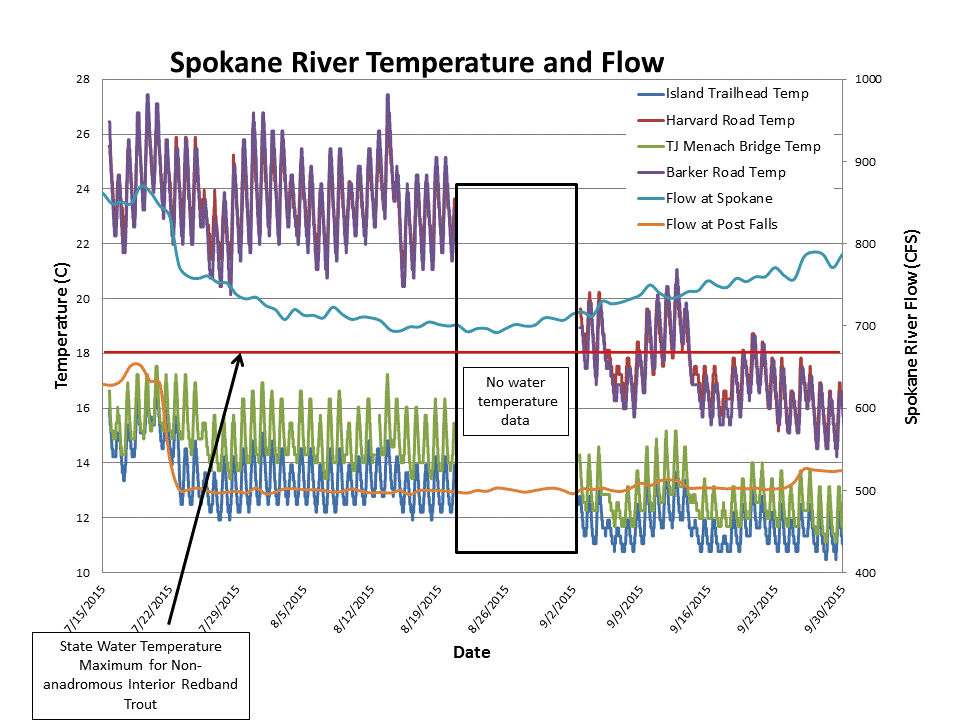
Our water temperature studies this summer reveal temperatures in the Spokane River and Hangman Creek that are much too hot for our native redband trout. Trout, our "canary in a coal mine", indicate cool, clean water and a healthy ecosystem. The high water temperatures we found this year reflect the state of our streams and rivers in the Inland Northwest, which in many cases lack riparian buffers and other common sense measures that improve water quality. The health of our streams depend on reestablishing riparian buffers in areas they have been removed, most of which are areas of intensive agriculture.
A note from the Spokane Riverkeeper: A huge thanks to our intern, Amy Shafer, for researching and writing this blog post. Her introduction to PCBs comes at a crucial time in Washington State for toxins in our waters. The EPA recently proposed an alternative water quality standard and Federal Human Health Criteria that is superior to Washington State's draft proposal. In the State's rule, the allowable cancer risk rate of those who consume fish from Washington State waters is raised from one case of cancer in one million citizens to one case in one hundred thousand citizens. This has implications for all people who catch and east fish in Washington State, especially those who consume larger amounts of fish, who are very young or are pregnant. The Spokane Riverkeeper supports the adoption of the proposed EPA rule which calls for the more protective 1:1,000,000 cancer risk rate. Please comment here or wait and watch our Facebook page and email blasts for the "talking point" highlights from Riverkeeper comments. Most people in the Spokane area are aware that the Spokane River is polluted. But what is it that’s actually polluting and harming the river and the animals in and around it? PCBs are toxic substances that are greatly affecting the Spokane River and pose a risk to human health.
What are they?
PCB stands for Polychlorinated Biphenyls. These are two benzene rings with 1-10 chlorines attached to them. There are 209 different arrangements of chlorine on these structures and these are called cogeners. PCBs are chemicals that come from old electrical equipment and modern day dyes and pigments. They travel via the air and water, becoming attached to sediments and particles in the water of the Spokane River. They move through the food web of aquatic animals and make their way up the food chain to humans who are eating the fish from the River. PCBs were initially developed in 1929 and were used in several types of equipment because they did not break down, burn, or conduct electricity. They were made illegal in 1979 but the laws allowed some uses to continue under allowable levels of toxicity.
Where do they come from?
PCBs were originally used in many things. They were found in transformers, capacitors, lubricants, caulk, paint, lamp ballasts, florescent lighting, and even newsprint. When PCBs were made illegal these stopped being manufactured but those that were already in use were permitted to continue being used. In addition to these legacy manufactures, there are 70 known manufacturing processes that are inadvertently making PCBs that continue to occur because PCBs are made as a byproduct. The most well-known and studied of these processes is the making of dyes and pigments. PCBs have been found to correlate with brighter colors in paints, pigments, inks, and dyes so it is found in most colored papers, cardboard, plastics, and textiles. The PBCs get released into the environment through manufacturing, use, disposal, and recycling processes.
PCBs travel through the air until they are eventually deposited onto surfaces where they are then washed away through water and end up in areas like the Spokane River. They don’t dissolve in water and instead attach themselves to mud, organic particles, and sediments at the bottom of the river. The organic particles in the river are then consumed by invertebrates, which are generally at the bottom of the food chain. PCBs are stored in the fat of animals so when that animal gets eaten, all of the PCBs it consumed in its lifetime end up in the predator that ate it. This results in a higher concentration of PCBs in animals’ systems the higher up the food chain one goes. This process is known as bioaccumulation. By the time PCBs reach fish in the Spokane River, the amount of PCB in the tissue is dangerous to consume.
What do they do?
PCBs increase the risk of cancer and other health issues in animals and humans. Studies of people who have been highly exposed to PCBs have shown that PCBs cause skin rashes, immune disorders, liver disease, reproductive disorders, and neurological and behavioral problems, and cancer. While PCBs are dangerous for everyone, there are some people who are especially at risk. People are more likely to come in contact with PCBs if they work around contaminated equipment and materials, work in buildings with PCB materials or florescent light ballasts, or consume fish and seafood from contaminated waters. Small children are more likely to be affected by PCBs as they are still developing and growing and pregnant women who are exposed to high levels of PCB have infants who tend to show neurobehavioral problems. PCBs are stored in fat rather than blood and the human body absorbs it rather than secretes it. Because the body does not remove PCB from its system, the amount of PCB in an individual will increase with age. In 2014 PCBs were reclassified from “probable human carcinogens” to “human carcinogens” by the International Agency for Research of Cancer.
Experiments have been run throughout Washington to find the effects of PCBs on various animals that have been exposed to them. Fish, birds, and mammals such as sea lions, seals, and mink have shown negative effects of exposure to PCBs. They all had reproductive problems, poor muscle coordination, week immune systems, and deformities in their skin and skeletons.
What are we doing about this issue?
The Spokane Riverkeeper mission is to protect and restore the health the Spokane River watershed, and accomplishes that goal through collaborating, educating and when necessary litigating. In 2011 the Spokane Riverkeeper helped create the Toxics Task Force. Its job regarding PCBs is to identify sources of PCBs and reduce the amount of PCBs in the Spokane River. The Task Force is making efforts to consolidate data about PCB sources, transportation, and what becomes of them. They are working on finding the different sources that are involved in dispersal of PCBs through stormwater. They did a massive data collection during dry weather and they intend to do another collection later during a wet season. The Spokane Toxics Task Force is also trying to identify and reduce PCB production in consumer products where PCBs are a byproduct
Another way we have been trying to bring about change is through political arenas. The Spokane Toxics Task Force has worked for PCB restriction, encouraged purchase of low and non-PCB products for public use, and addressed the need to reduce inadvertently made PCBs. In June of 2014 the City of Spokane enacted an ordinance that had a preference for City purchases to be PCB free. We are also working on public outreach. Measures are being taken to educate the community about what PCBs are and the dangers that they bring about. One example is fish advisories that have also been created by the Washington Department of Health to let people know what fish is safe to eat and where in the river it can be caught from. (see image below). Additionally, all Washington Waterkeeper's are advocating for the most protective Human Heath Criteria as proposed in the EPA's draft rule. The Spokane Riverkeeper will be asking people to sign letters, and make comments in support of a very protective rule. Such a rule will help in the reduction of PCBs entering.
Why should you care?
Being aware of health issues in the community is key to keeping yourself and your family healthy and happy. When you go to swim in the Spokane River you should be sure to wash off hands, feet, face, and toys before eating or leaving. If you eat fish from the Spokane River you should be sure to eat no more than the advised amount set by the Washington Department of Health.
We at Spokane Riverkeeper are doing all that we can to stop pollution of the Spokane River and keep our environment clean. We cannot do this alone though. You can also help your community by donating money or volunteering your time to help us out. The Spokane River clean-up was a huge success this year and we owe that to citizens of Spokane like yourself. Stay informed of what’s going on in your local community and take ownership for the beautiful environment around you. This river belongs to all of us, let’s make it something to be proud of.
Our guest author, Amy Shafer, is a senior at Gonzaga University studying biology and political science, with aims to work in environmental policy. She interns as a our PCB Outreach Coordinator.
 The Spokane Riverkeeper is thrilled to announce that the 2015 Mike Chappell River Hero Award goes to Andy Dunau. Although we don't have strict criteria for selecting who receives the River Hero Award, we all agree that it is given to someone whose work helps preserve and protect the Spokane River. There is no doubt that Andy's work does just this, but before I explain further, I wanted to give a bit of history.
The Spokane Riverkeeper is thrilled to announce that the 2015 Mike Chappell River Hero Award goes to Andy Dunau. Although we don't have strict criteria for selecting who receives the River Hero Award, we all agree that it is given to someone whose work helps preserve and protect the Spokane River. There is no doubt that Andy's work does just this, but before I explain further, I wanted to give a bit of history.
In 2011, the Spokane community lost a real hero when Mike Chappell, then director of Gonzaga’s Environmental Law Clinic and one of the driving forces behind starting Spokane Rivekeeper suddenly passed away. That year, we held Dirty Martinis for Clean Water a mere few weeks after Mike’s passing and while on stage we announced that starting next year we’d do something to recognize Mike’s legacy of work on Spokane River issues. Since then, we have honored Russ Nobbs, Steve Faust, and Twa-le Abrahamson.
Andy's tireless work for the river comes from a vision to connect the Spokane River with the city and people of Spokane. As he puts it, he wants the river to be part of our DNA. As the river becomes a driving force in our economy, he realizes the importance of connecting people to the river. He does this through convening people and groups to discuss river issues and creating individual opportunities to make a difference.
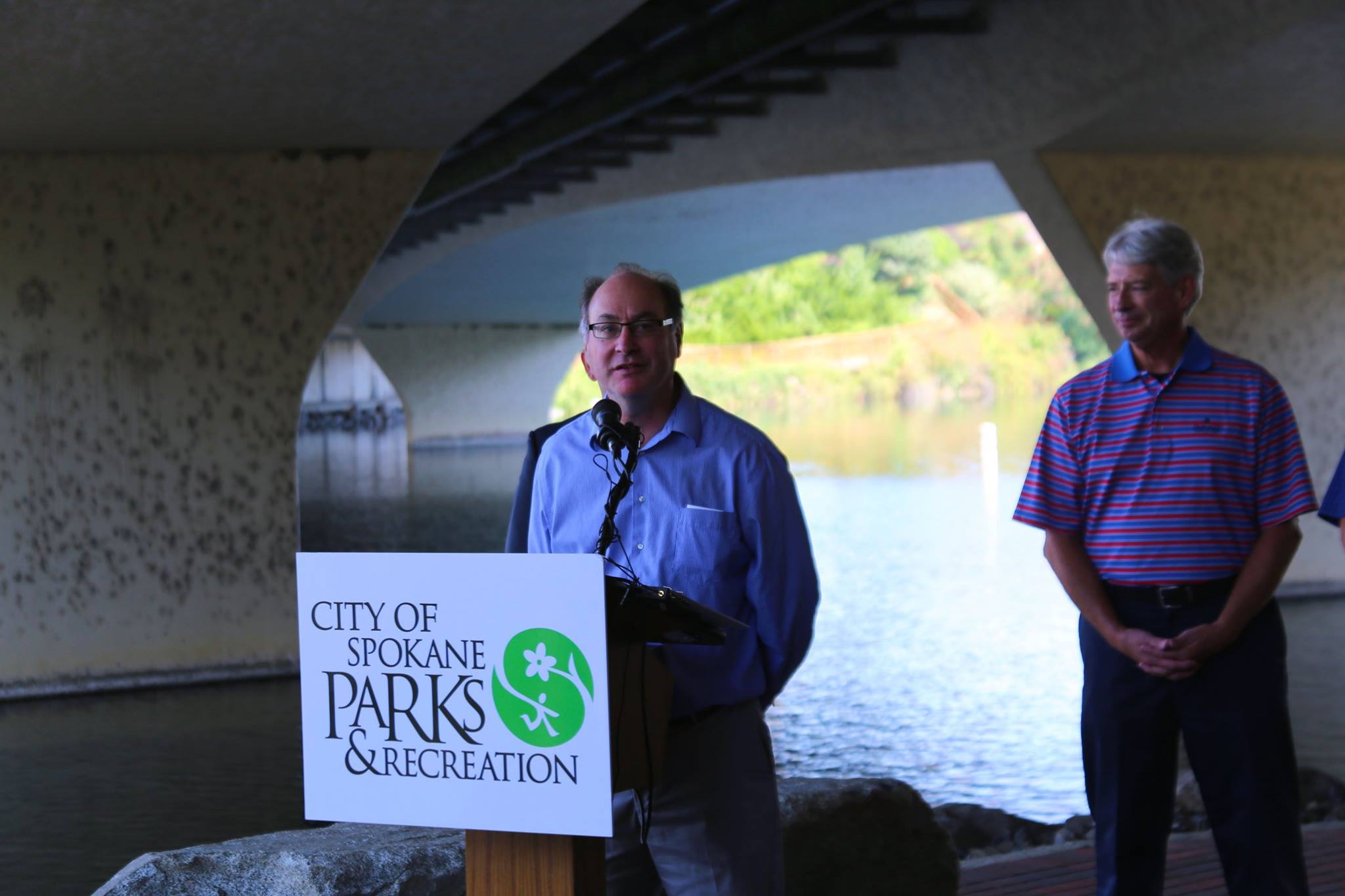 Andy's love of the river started with an opportunity to create the Spokane River Forum. His work heading the Spokane River Forum led him to understand that experiences on the river them lead people to love it. The Spokane River Forum acts as an information clearinghouse, distributing important technical documents, river news, and most importantly, the Spokane Water Trail. Essentially a "one stop shop" for all things Spokane River, the Spokane Water Trail is an online resource that provides recreationalists information on boat launches and facilities along the Spokane River. Andy doesn't just sit behind a computer. Since 2008 he has paddled the entire Spokane River and connected over 700 people to the River through river floats. He realizes he cannot do it all though and has worked behind the scenes to provide more access to the river, such as under the Division Street Bridge (see photo above).
Andy's love of the river started with an opportunity to create the Spokane River Forum. His work heading the Spokane River Forum led him to understand that experiences on the river them lead people to love it. The Spokane River Forum acts as an information clearinghouse, distributing important technical documents, river news, and most importantly, the Spokane Water Trail. Essentially a "one stop shop" for all things Spokane River, the Spokane Water Trail is an online resource that provides recreationalists information on boat launches and facilities along the Spokane River. Andy doesn't just sit behind a computer. Since 2008 he has paddled the entire Spokane River and connected over 700 people to the River through river floats. He realizes he cannot do it all though and has worked behind the scenes to provide more access to the river, such as under the Division Street Bridge (see photo above).
Among his other accomplishments, Andy lists the increased communication between river advocacy groups and industry. "I wanted to make it safe to be in a room to talk about river issues" said Andy , alluding to the dialogue that he changed through the Spokane River Forum. "Mike Chappell taught me a culture of convening diverse groups, not to argue, but to communicate". Andy offers individuals a way to give back to the river now too. The Spokane River Forum coordinates volunteer opportunities for litter clean up, tree planting, and restoration days for individuals or groups.
The Spokane Riverkeeper would like to sincerely thank Andy Dunau for all he has done for our river.
The summer of 2015 brought historically hot and dry conditions to the Inland Northwest. Record low rainfall and record high heat, combined with very low snowpack, caused record low flows on the Spokane River. We knew little about what these conditions would have on water temperatures in the Spokane River, so we placed continuous water temperature loggers in a few areas of the river. Due to the complex interaction between the Spokane-Rathdrum Prairie Aquifer and the Spokane River, we expected to see a wide range of water temperatures. What we found were water temperatures that reflected the complex interaction with our aquifer, upriver temperatures that were too hot for our native Redband Trout, and data that led to many more questions. First, a bit of Spokane River hydrology. The Spokane River flows out of Lake Coeur d'Alene and over the Post Falls Dam. The water in this "losing reach" of the Spokane River between Lake Coeur d'Alene and Sullivan Road is slowly seeping into the ground, replenishing our groundwater. Water temperature in this stretch of the river should be similar to the water temperature at the surface of Lake Coeur d'Alene, plus any warming that occurred in the river. Ground water also feeds the Spokane River. The Spokane-Rathdrum Prairie Aquifer, provides cool groundwater to the "gaining reaches" of the Spokane River (see map below), which come in mostly below Sullivan Road. Water temperatures in and downriver of these gaining reaches should be much cooler than the upriver section of river, depending on the proportion of cool aquifer water in the river.
In late June we saw dead fish and measured very warm temperatures in the Spokane River near Barker Road. This prompted us to place temperature loggers at five locations along the Spokane River in early July. Two at losing reaches in the upriver section at Harvard Road and Barker Road and three at gaining reaches at Islands Trailhead, Water Street (downstream from downtown), and TJ Meenach Bridge (see map below). 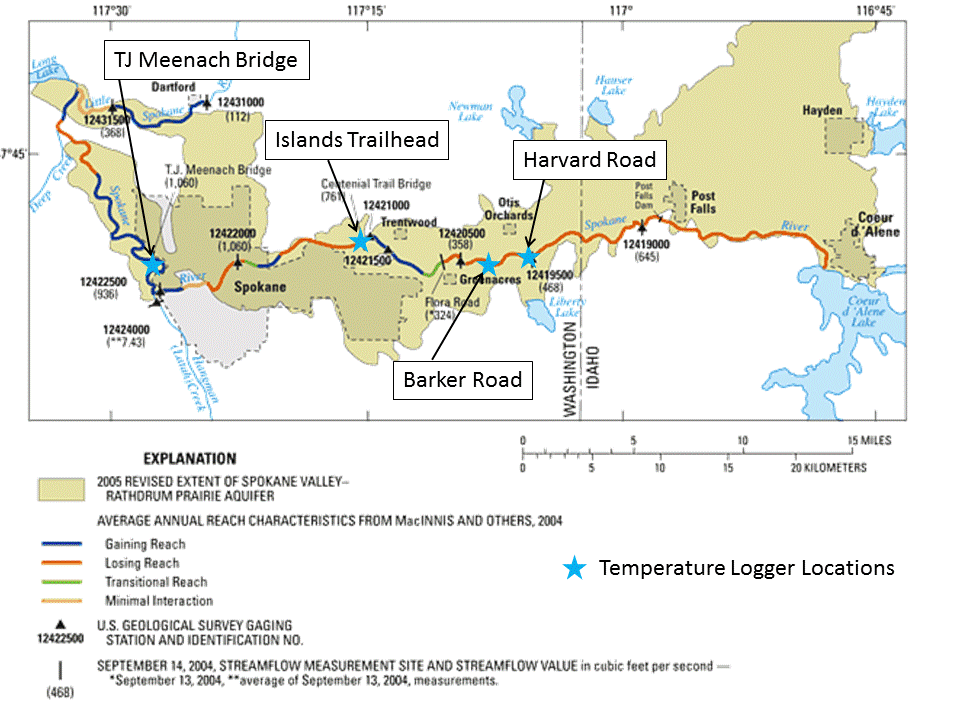 Our method was simple, we placed Hobo Tidbits temperature data loggers which we set to record water temperature every 30 minutes in a short PVC tube for shade. They were then placed in the river at a depth of about two feet. The logger placed at Water Street was stolen, but the other loggers recorded temperature data from 7/16/15 to 8/20/15.
Our method was simple, we placed Hobo Tidbits temperature data loggers which we set to record water temperature every 30 minutes in a short PVC tube for shade. They were then placed in the river at a depth of about two feet. The logger placed at Water Street was stolen, but the other loggers recorded temperature data from 7/16/15 to 8/20/15.
Water temperatures in the Spokane River varied dramatically between some locations. The average temperature at Harvard and Barker Road was 23.6 and 23.5 C, respectively, while the temperature downriver at Islands Trailhead and TJ Meenach Bridge was 13.6 and 15.1 C, respectively. This is a difference of over 8.5 C (15 F). This difference shows the influence of the aquifer on the down and upriver sections of river.
| Data Summary of Spokane River Temperature Gages (summary courtesy of Allan Scholz of EWU) | |||
| Location | Dates (inclusive) | Average temp (C) | Range of daily average temp (C) |
| Islands Trailhead | July 16 – August 20 | 13.6 | 12.7 (on 8/20) – 15.9 (on 7/20) |
| Harvard Rd | July 16 – August 20 | 23.6 | 22.3 (on 7/27) – 24.7(on 8/13) |
| TJ Meenach | July 16 – August 20 | 15.1 | 14.2 (on 8/20) – 17.1 (on 8/12) |
| Barker Rd | July 16 – August 20 | 23.5 | 21.7 (on 7/26) – 25.5 (on 7/20) |
Looking at the data graphically, it gets a bit more interesting (see graph below). The upstream loggers at Harvard and Barker Road showed very similar patterns. Comparing the upstream loggers to the minimum and maximum air temperatures in Spokane (data courtesy of NWS Spokane), shows that warmer air temperatures translate into warmer water temperatures (no surprise there). Differences between daily maximum and minimum water temperatures at the upriver loggers were about 5 C, and varied between about 20 C and 27 C.
The two loggers influenced by the aquifer, at Island Trailhead and TJ Meenach Bridge, showed much cooler temperatures, small temperature variation, and seemed to be influenced less by air temperature than by other factors. Temperatures at these locations varied by about 2 C daily, between approximately 12 and 17 C degrees at Island Trailhead and 14 and 17 C degrees at TJ Meenach Bridge. Although daily air temperatures do seem to affect water temperatures at these locations, another factor may have an even larger affect.
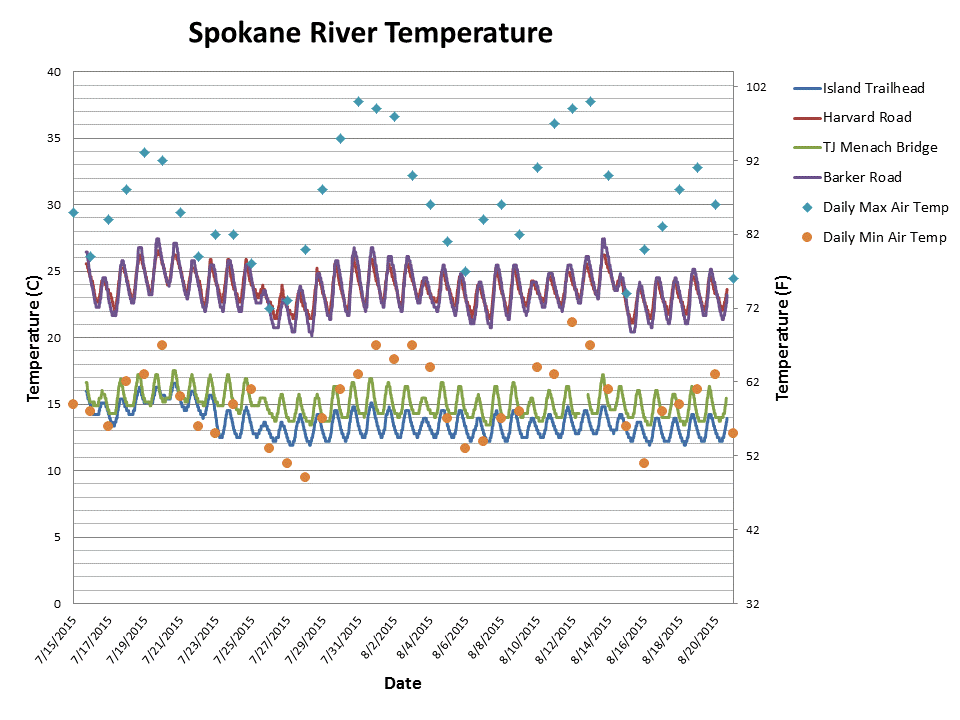 After 7/23/15 water temperatures at Island Trailhead become much colder than that at TJ Meenach Bridge, having remained similar for the previous week. This divergence in water temperature correlated with the reduction in flow out of the Post Falls Dam (see flow graph below) from 640 cubic feet/second (cfs) to 500 cfs. The drop in water temperature at Islands Trailhead could be due to the reduction of warm water flowing over the dam and into the river, increasing the proportion of the cool aquifer water in the river at Islands Trailhead. Although this explains the drop in temperature at Islands Trailhead, it does not explain the divergence of water temperatures between Islands Trailhead and TJ Meenach Bridge. More data will be required to explain why temperature at TJ Meenach remains more or less constant, while flow seems to affect water temperature at Islands Trailhead.
After 7/23/15 water temperatures at Island Trailhead become much colder than that at TJ Meenach Bridge, having remained similar for the previous week. This divergence in water temperature correlated with the reduction in flow out of the Post Falls Dam (see flow graph below) from 640 cubic feet/second (cfs) to 500 cfs. The drop in water temperature at Islands Trailhead could be due to the reduction of warm water flowing over the dam and into the river, increasing the proportion of the cool aquifer water in the river at Islands Trailhead. Although this explains the drop in temperature at Islands Trailhead, it does not explain the divergence of water temperatures between Islands Trailhead and TJ Meenach Bridge. More data will be required to explain why temperature at TJ Meenach remains more or less constant, while flow seems to affect water temperature at Islands Trailhead.

Water temperatures in our river affect our native Redband Trout, a fish that needs cool, clean water to survive. Water temperatures seen this summer in the upper river are much too high for trout (see graph below). In fact, trout numbers in this stretch of the river are dropping. Although competition and predation from other fish likely play a role, during some summers water temperatures are much too hot for trout in this section of river.
Next summer the Spokane Riverkeeper hopes to expand this study. If we can find funding to purchase more temperature data loggers, we can monitor more sections of the Spokane River, including tributaries. Our studies will provide long term data in a river system that has complex temperature dynamics, that as far as we know, is not being taken by any one else.
The new Downtown Spokane River Access Point opens this week. Located directly under the Division Street Bridge off of the Centennial Trail on the south side of the Spokane River, the launch provides canoers, kayakers, and paddleboarders convenient water access in downtown Spokane. I launched the Riverkeeper canoe there this week for my weekly litter pickup and thought I would give you a quick guide to the Division Street Boat Launch.
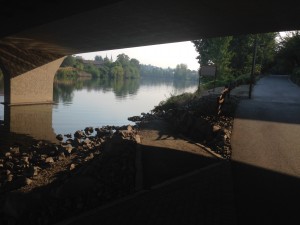
The launch provides walk up access to the water on a six foot wide gently sloping gravel path making it easy to launch canoes, kayaks, and paddleboards. However, vessels without paddles such as inner tubes and small rafts should not be launched here because the upper falls dam is directly downstream of the launch (in fact it is illegal to float west of the Division Street Bridge). Large rafts and boats cannot be launched here as well.
Parking: I unloaded my canoe at the Courtyard by Marriott, which is the closest parking lot to the access point. I checked with the front desk and they are happy to let river users load and unload gear in their parking lot, but do not allow parking for non hotel users. After unloading, I parked at the metered all day on street parking on Spokane Falls Blvd. and Pine ($1 per 2.5 hours, bring change). If you are just out for a quick paddle, one hour free parking is located on E. Olive Way, in front of the Marriott. Alternately, the Convention Center has covered pay parking in its parking garage or you could park in one of the many lots operated by Diamond parking near the River Access.
Using the River Access Point: I quickly navigated the stairs and ramps down to the River Access lugging our 80 pound canoe. After that it is an easy walk down to the Spokane River on the graveled ramp. This year water levels in the Spokane River are very low, creating a perfect low current environment to launch our canoe. I simply placed the canoe in the water, donned my PFD, and paddled away. I didn't want to set my canoe down on the rocks at the bottom of the ramp and risk dinging it. During higher flows or high winds an anchor or rope would be handy to prevent your vessel from drifting away.
On the Water Experience: From the River Access Point, you must paddle upstream (east) to avoid the Upper Falls dam. However, there are plenty of warning signs so don't worry about getting confused. Traveling east along the river is a serene, flat water experience, with little current and incredibly clear water. No rapids exist in this stretch of water, making it an ideal place to paddle. I saw numerous trout rise and plenty of large sucker fish on the rocky river bottom. The riverbank along this stretch of the Spokane River is tree lined and somewhat steep, with the views of the Centennial Trail and the occasional office building. The aquifer feeds this part of the Spokane River, creating remarkably cold and clear water. I easily paddled up to the No-Li brewery and back in about 2.5 hours, stopping to pick up some litter along the way.
Summary: The Downtown Spokane River Access Point provides a very easy way for canoers, kayakers, or paddleboarders to get a quick paddle in on a unique stretch of the River. Opening this stretch of river allows easy access for people working downtown a great lunchtime (or pre/post work) paddle. From almost anywhere in downtown Spokane you can be on the River in minutes!
Yesterday, July 1st, I took some temperatures in the Spokane River and Hangman Creek. As you can see in the table below, water temperatures in parts of the Spokane River and Hangman Creek are very hot. In fact, the Spokane River at Barker Road measured 28.3 C (83 F)! Hangman Creek measured 26.3 C (79 F).
Location |
date |
time |
air temp (C) |
water temp (C) |
Water Street |
7/1/2015 |
1500 |
22.2 |
16.7 |
TJ Menach |
7/1/2015 |
1430 |
27.2 |
17.7 |
Hangman at 11th Street Bridge |
7/1/2015 |
1445 |
21.7 |
26.3 |
Barker Road |
7/1/2015 |
1530 |
24 |
28.3 |
Plantes Ferry |
7/1/2015 |
1550 |
17.3 |
Today, it was reported that Columbia River temperatures at Bonneville dam are the hottest since 1950. Air temperatures in this area usually peak at the end of June and the beginning of August. So the area will endure at least another month of warming waters. And although people have ways of keeping cool, our aquatic life are stuck with these temperatures. Trout are stressed at 70 F and begin to die at 80 F, temperatures we are already measuring in part of the river.
As you can see, parts of the river are still very cold. Downriver from Spokane, water temperatures measure between 16 and 18 C (61 and 64 F). This is due to the influence of our amazing aquifer, which flows into the Spokane River here. In the map below, the blue area shows where the aquifer flows into our river, cooling it and also providing a bit of extra flow. 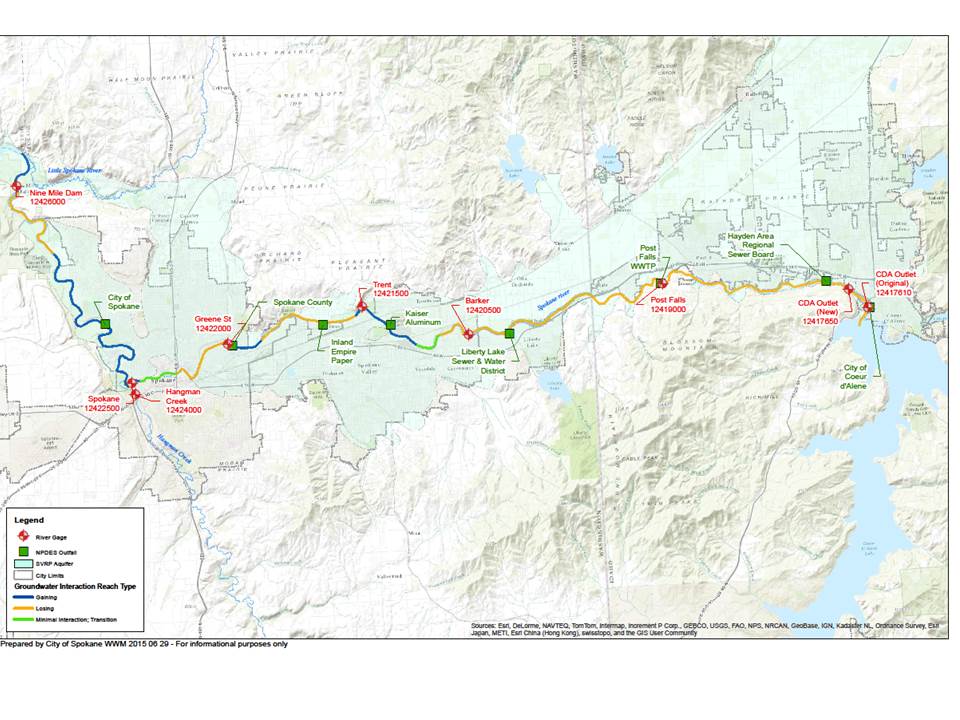
With these temperatures anglers should consider "hoot owl fishing" (early morning) to reduce stress on the native trout they catch and release.
This week Dan Partridge of the State Department of Ecology announced that the snowpack in Washington State is at zero percent of normal. Snowpack feeds our surface waters, slowly melting and flowing into our rivers and reservoirs. With no snow in the mountains, the flows in our rivers are severely reduced. The Spokane River is no exception and as a result, flows are at record lows. The graph below of flows of the Spokane River at Spokane shows past and current flow as a blue line and historical minimum flow as a blue triangle. For example, on 6/17/15 the Spokane River flowed at just over 1,100 cubic feet per second (cfs). The historical minimum for June 17th is just under 2,000 cfs.
In other words, we set a new minimum flow today, at almost half of our historical minimum. 
These historic lows are about 1/10 of average. The historical mean on this day is just over 10,000 cfs. Clearly the lack of snow in the mountains has a dramatic effect on our Spokane River flows.
Other factors influence the flow of the Spokane River other than snow. The Spokane River flows from Lake Coeur d'Alene, through the Post Falls dam, and interchanges with the Spokane-Rathdrum Prairie Aquifer along the way. Currently, Avista is releasing 619 cfs out of Lake Coeur d'Alene. Their FERC (Federal Energy Regulatory Commission) to release 600 cfs from the Post Falls dam. At Spokane, the gauge reads 1120 today. So the extra 501 cfs (1120-619), comes from our aquifer.
What does this mean for river users? The whitewater rafting season was cut dramatically short. Fisheries closures on the Spokane River are a possibility in the Upper River, due to the high temperatures created by the low flows. Of course, on a positive note, low water levels reveal more garbage for our river litter clean up program to clean up!





